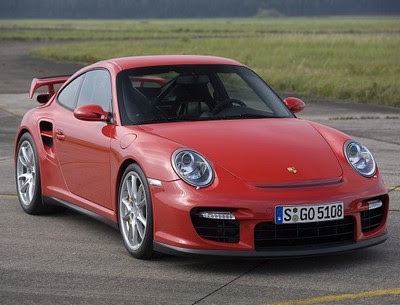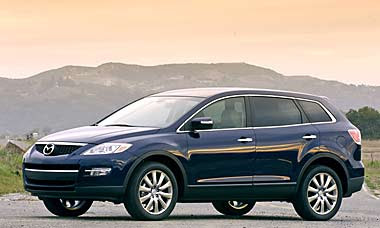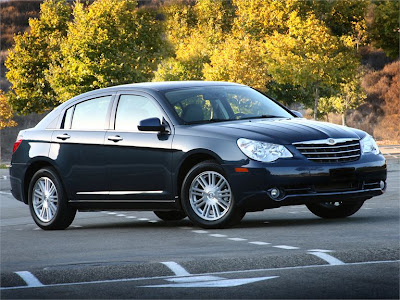
Spring is upon us and with it the season when a car buyer's thoughts turn to convertibles. For me, that means it's also a good time to say a few kind words about the BMW Z4 Roadster, a great little ragtop two-seater that has never gotten the sales or critical acclaim it deserves. Until recently, at least.
In terms of increased sales, the Z4 is the hottest-selling BMW in the U.S. market so far this year, though admittedly from a small base. Sales of all Z4 models combined soared 90.6%, to 1,906 units, in the first quarter of the year vs. the same period in 2006, partly driven by the addition of the new Z4 Coupe to the lineup. But what I find encouraging is that the plain old Z4 Roadster saw a 68% sales increase during the quarter, an early indication that consumers may be wising up to the fact that this is a much better car than auto reviewers have rated it. If you're looking to splurge on a midlife-crisis car this spring and have a fair amount of money to spend, the '07 Z4 definitely merits a test drive.
One thing I like about the Z4 Roadster is what many reviewers revile it for: its looks. Perish the thought, but the Z4 actually looks different from all the other cars on the road. The Z3, the model the Z4 replaced, had a classic, almost retro, look to it, while the Z4 is perhaps the most unabashed example of BMW designer Chris Bangle's "flame surface" styling, in which the car's sheet metal is sculpted to have multiple surfaces reminiscent of a flickering flame. Adding to its distinctiveness, the Z4 has an extra-long front end and a stubby, humped rear end with an odd little ducktail on the rear deck.
In an age of curvy, rounded vehicles that all look alike, the Z4 is instantly recognizable when you see it coming down the road. But it's a love-it-or-hate-it sort of design that has turned off many BMW aficionados. There are persistent rumors that Bangle's protégé, Adrian van Hooydonk, who became chief designer for BMW's car company when Bangle moved upstairs to oversee design for the entire BMW Group, will redo the Z4 for the '09 model year and give it a less radical design. I hope Z4 sales will continue to soar—proving that Bangle's bold design isn't a detriment to the model's commercial prospects.
Exterior styling aside, the Z4 Roadster is a classic sports car—quick, tight-handling, and with a catlike grip on the road. The engine lineup was also upgraded as of the '06 model year, so all versions of the car have plenty of power.
Like any BMW, it isn't cheap. The basic 3.0i, which is powered by a 3.0-liter, 215-hp, inline six-cylinder engine, starts at $37,175, while the more powerful 3.0si, which has a 255-hp, inline six, starts at $43,175. If you prefer a hardtop, the Coupe version of the Z4 3.0si starts at $41,175. And if blinding speed is your priority, the M version of the Z4—which has a 330-hp 3.2-liter engine—starts at $53,875 for the ragtop and $51,875 for the Coupe (see BusinessWeek.com, 7/26/06, "Hard Core Z4").
However, my feeling is that if you want a classic ragtop sports car, you don't necessarily have to spend a lot of money going for the biggest engine and adding bells and whistles to the Z4. You buy a sports car mainly for handling, not raw speed. And going with the entry-level Z4 is a little like going with the BMW 328i rather than the 335i: You give up a little speed and save a lot of money (see BusinessWeek.com, 10/17/06, "BMW's Super Coupe").
If my own money were on the line, I'd go with the basic Z4 3.0i, and about the only option I'd pay up for is the $3,550 Premium package, which includes an automatic convertible top, auto-dimming rearview mirrors, power seats, and a few other add-ons. If you want an automatic transmission, add another $1,275 to the price.
The bottom line is that you can get a well-equipped Z4 3.0i for a little more than $40,000. That's a lot of cash, but it's still thousands of dollars less than a Porsche Boxster.
You can even rationalize the purchase by telling yourself the Z4 is an economy car when it comes to gas mileage. The 3.0i is rated to get a respectable 21 mpg in the city and 30 on the highway. In a stretch of 200 miles of mixed driving, I got 22.6 mpg in a Z4 3.0i with an automatic transmission, which isn't bad considering how hard I pushed the car.
Behind the Wheel
Slip into the driver's seat and the Z4 is, unapologetically, a sports car. It has the small, spoked steering wheel that old-style European sports cars always had and a clean, uncluttered interior that contrasts sharply with its busy exterior styling. There isn't a lot of extra shoulder and head space in the cabin (unless, of course, the top is down), and legroom may be too tight if you're unusually tall.
The suspension is stiff and the ride relatively hard. If you don't want to bounce around on the highway and feel a hard thump when you hit a bump in the road, this isn't the car for you. You're also sitting very low to the ground in the Z4, and it's a struggle getting in and out, especially with the top up. But the seats are comfortable and more supportive than I remember the ones in the Mazda Miata being.
Like any classic sports car, the Z4 Roadster is a blast to drive. My test car came with the six-speed automatic transmission with a manual shifting mode and steering wheel-mounted paddle shifters. And this automatic is so refined that it makes you wonder how much longer even companies like BMW will continue offering stick shifts.
If you let the transmission do the shifting for you, it's incredibly smooth, running through the gears as if a professional driver were behind the wheel. The transmission never revs unnecessarily or hunts for the proper gear, even when you accelerate hard up a steep hill. At the push of a button, you can put the car in a sporty mode that noticeably alters the transmission's shifting algorithms and makes it quicker and jumpier.
If you're a real speed freak, the basic Z4 3.0i won't be fast enough for you. BMW rates it at 6.6 seconds in accelerating from a standing stop to 60 mph with an automatic transmission, and I clocked it at about seven seconds. That's noticeably slower than the 3.0si, which BMW says will do zero-to-60 in 5.7 seconds with an automatic and 5.6 seconds with a stick shift, but it's plenty quick for most people.
The 3.0i is geared to be very quick in the midrange and at normal passing speeds on the highway. When you get above 80 mph, there's not a lot of oomph left when you punch the gas, and the car starts to struggle a bit. If you want a real German-style autobahn cruiser, you need the extra power of the Z4 3.0si or the M. But for most normal U.S. driving, the basic Z4's power and speed are more than adequate.
As with any sports car, the Z4's interior is short on storage space. The glove box and storage bins in the doors are small. There's a box-like storage space in the back wall of the cabin big enough to hold a small purse. Happily, though, the trunk is quite big for a sports car and remains a relatively spacious 8.5 cubic feet even with the top down.
Speaking of the convertible top, I'd definitely pay extra for the optional power top, which is very handy. It goes up or down without human intervention in about 10 seconds. You don't have to worry about getting caught in sudden rainstorms because the top is so quick and easy to put up.
Buy It or Bag It?
For most people, buying a two-seater sports car isn't a rational decision; it's a splurge. And the key question always is: How big a splurge do you want to make?
If you're on a tight budget, there are tons of cheaper convertibles to choose from. The Mazda Miata (see BusinessWeek.com, 12/13/06, "Mazda: More Miata for the Money") is probably the most attractive low-priced alternative. General Motors' (GM) Pontiac Solstice (see BusinessWeek.com, 10/14/05, "Solstice: A Brawny Beauty") and Saturn Sky (see BusinessWeek.com, 5/30/06, "Sky High") are very cool-looking, but have the disadvantage of having virtually no trunk space when the top's down.
Closer to the Z4's price range but still considerably cheaper are the Nissan (NSANY) 350Z (see BusinessWeek.com, 7/09/06, "Z as in Zoom") and the Honda (HMC) S2000, both of which are sweet-handling cars. The Power Information Network figures the Z4 had an average selling price in the first quarter of $45,526, vs. a little more than $32,000 for the S2000 and 350Z.
As I mentioned above, a well-equipped entry BMW Z4 3.0i will set you back a little more than $40,000—but even that's a huge premium over the Honda and Nissan. To justify the extra expense, you have to like the Z4's radical styling and you have to be willing to pay a bit more for the cachet of owning a Bimmer.
The other key question is whether it's worth paying more to get a Porsche Boxster, which feels even more solid on the road and handles a little better, and which Power figures had an average selling price of $53,114 in the first quarter (see BusinessWeek.com, 10/28/05, "Porsche's Entry-Level Dream").
Price being equal, I'd rather have a Boxster than a Z4. But given the price differential, it's a tough choice. The Z4 handles nearly as well as a Boxster, is more distinctive-looking—and costs thousands of dollars less. Much as I love the Porsche, the Z4 is a tempting alternative.









